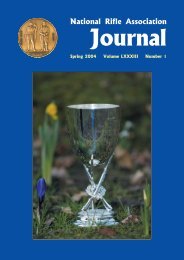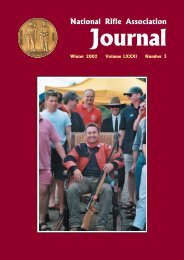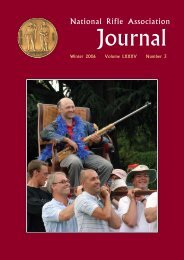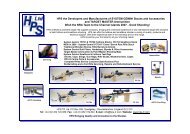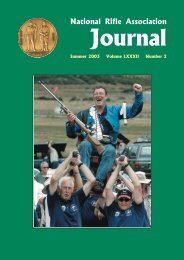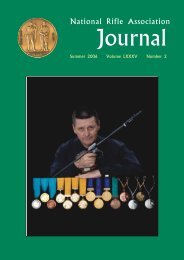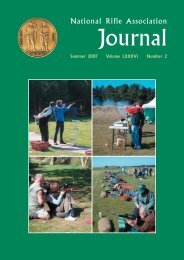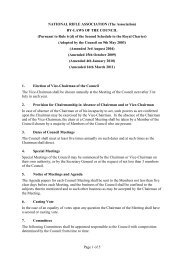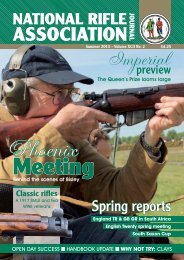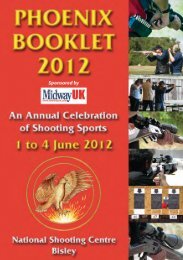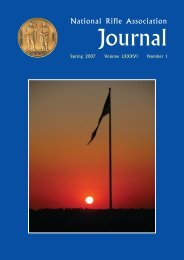NRA Journal - Spring 2011 - National Rifle Association
NRA Journal - Spring 2011 - National Rifle Association
NRA Journal - Spring 2011 - National Rifle Association
Create successful ePaper yourself
Turn your PDF publications into a flip-book with our unique Google optimized e-Paper software.
A Response to Range Closures: Long Range Shooting withthe .22” Long <strong>Rifle</strong> Cartridgeby Richard KenchingtonRange Closures and Future ProspectsThose who have been involved in fullbore rifle shootingsince the 1970s will be only too well aware of the loss ofMoD ranges which has taken place in the last 40 years.At least two thirds of the ranges accessible to civiliansin 1970 have since been closed. For example, in theWest Midlands and Gloucestershire, the loss of Pilningand Tyddesley Wood has left just one operationalrange, Kingsbury, which may yet be vulnerable ifthe High Speed 2 railway is built. The requirementsof the military for range space at Kingsbury and thenearest range to the south-west (Severn Tunnel) meanthat civilian use is severely restricted and liable tocancellation at short notice, whilst the continued cutsin defence spending can only squeeze civilian fullboreshooting further out of the MoD’s future concerns.These political changes have made it increasinglydifficult for clubs to find anywhere to practise usingservice calibre rifles. In addition, over the same 40year period, the cost of fullbore shooting has risenmuch faster than inflation and is now a significantdiscouragement to individuals from starting, andperhaps from continuing, to take part. These factorsneed to be addressed realistically and practicalsolutions found, otherwise the prospects for provincialopen range target shooting, which are already verypoor, are likely to deteriorate further.Essentials of Target <strong>Rifle</strong> ShootingThe enjoyable thing about fullbore rifle shooting at therelatively long ranges customary for Target and Match<strong>Rifle</strong> is the sense of achievement when winning thebattle with the elements, above all the wind. At longrange, the large wind allowances often needed and therisk of making low scores are essential components ofthe enjoyment of taking part. Whilst the recoil andnoise of discharge of a service calibre weapon are, atleast initially, another important part of the experience,as one grows used to them, it is the train of observationand thought (“how much wind do I allow?”) and theAnschutz Model 54 rifle fitted with Leupold 12x scope.result at the target which contribute most to the senseof enjoyment.In these times of contraction in the military, financialstricture and greater general awareness of safety andthe environment, it makes sense to use the cheapestand least violent means to puncture the bullseye,commensurate with acceptable accuracy. Onepossible way forward, which I feel deserves seriousconsideration, is the use for long range shooting(relative to its ballistic parameters) of the .22” Long<strong>Rifle</strong> (.22LR) cartridge..22LR BallisticsAlthough I have been interested in ballistics for severaldecades, it was only last year that my eye fell uponthe chapter on .22LR ballistics in Geoffrey Kolbe’sexcellent “Ballistics Handbook”, published in 2000.Kolbe’s condensed ballistic table indicates that if firedat an angle of elevation of 115 minutes, the 40 grains.22” bullet would travel 514 yards in 1.95 seconds,with a remaining velocity of 600 ft/s. It was theremaining velocity which impressed me. After nearlytwo seconds in flight, it still retains 55% of its muzzlevelocity of 1100 ft/s; in comparison, a Match <strong>Rifle</strong>bullet fired at 2750 ft/s only retains about 40% of itsmuzzle velocity after two seconds in flight, althoughby that time it has reached 1200 yards.Perhaps the ballistic performance of the .22LR cartridgeis not quite as poor as is commonly supposed. At100 yards, the angle of elevation is 16 minutes andthe wind deflection in a 20mph cross wind is 4 or 5minutes, which are about the same figures as for a7.62mm TR at 450 yards. Going further back, at 300yards the .22LR requires an elevation of 63 minutesand a 20mph wind allowance of about 20 minutes,not dissimilar to a 7.62mm MR at 1100 yards. Thesefigures suggest that one could successfully engagein “long range” shooting using the .22LR cartridgeat distances of up to 300 or perhaps even 400 yards.Some HistoryA long time ago, there were some who did try shootingthe .22LR at these long distances – indeed, around100 years ago, competitions for .22” rimfire at up to200 yards were included in the July <strong>NRA</strong> Meeting.Older competitors will remember that these rifleswere allowed in the Donegall, then fired at 200 yards,until 1967. I am told that a Col Turbutt of Derbyshirepresented a series of cups for shooting with the .22LRat 200, 300 and 500 yards in (respectively) 1947, 1953and 1960. The late Colin O’Brien won these trophiesseveral times. For his attempt at 500 yards he used aBSA International Mk II fitted with a cut down blade48



